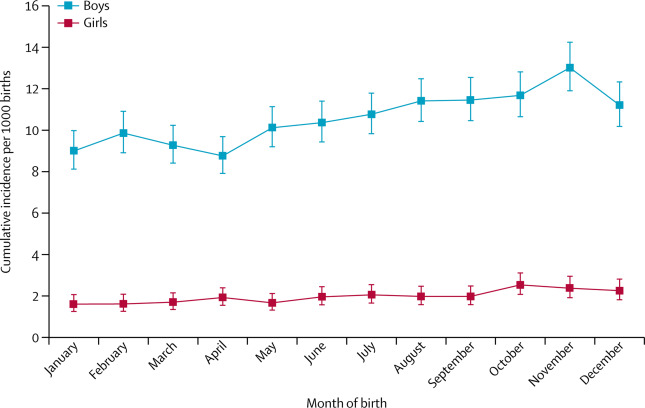The Lancet Psychiatry ( IF 30.8 ) Pub Date : 2017-10-09 , DOI: 10.1016/s2215-0366(17)30394-2 Kapil Sayal , Roshan Chudal , Susanna Hinkka-Yli-Salomäki , Petteri Joelsson , Andre Sourander

|
Background
Findings are mixed on the relationship between attention-deficit hyperactivity disorder (ADHD) and younger relative age in the school year. We aimed to investigate whether relative age is associated with ADHD diagnosis in a country where prescribing rates are low and whether any such association has changed over time or relates to comorbid disorders (eg, conduct disorder [CD], oppositional defiant disorder [ODD], or learning disorder [LD]).
Methods
We used nationwide population-based registers to identify all Finnish children born between Jan 1, 1991, and Dec 31, 2004, who were diagnosed with ADHD from age 7 years onwards (age of starting school). We calculated incidence ratios to assess the inter-relations between relative age within the school year, age at ADHD diagnosis, and year of diagnosis (1998–2003 vs 2004–11).
Findings
Between Jan 1, 1998, and Dec 31, 2011, 6136 children with ADHD were identified. Compared with the oldest children in the school year (ie, those born between January and April), the cumulative incidence of an ADHD diagnosis was greatest for the youngest children (ie, those born between September and December); for boys the incidence ratio was 1·26 (95% CI 1·18–1·35; p<0·0001) and for girls it was 1·31 (1·12–1·54; p=0·0007). The association between relative age and age at ADHD diagnosis reflected children diagnosed before age 10 years, and the strength of this association increased during recent years (2004–11). Thus, compared with children born between January and April, for those born between May and August, the ADHD incidence ratio was 1·37 (95% CI 1·24–1·53; p<0·0001) and for those born between September and December, the incidence ratio was 1·64 (1·48–1·81; p<0·0001). The relative age effect was not accounted for by comorbid disorders such as CD, ODD, or LD.
Interpretation
In a health service system with low prescribing rates for ADHD, a younger relative age is associated with an increased likelihood of receiving a clinical diagnosis of ADHD. This effect has increased in recent years. Teachers, parents, and clinicians should take relative age into account when considering the possibility of ADHD in a child or encountering a child with a pre-existing diagnosis.
Funding
Academy of Finland, Finnish Medical Foundation, Orion Pharma Foundation, Finnish Cultural Foundation.
中文翻译:

学年内的相对年龄和注意缺陷多动障碍的诊断:全国性人群研究
背景
关于注意力缺陷多动障碍(ADHD)和学年中相对年轻年龄之间关系的研究结果参差不齐。我们的目的是调查在处方率较低的国家/地区,相对年龄是否与ADHD诊断有关,以及这种关联是否随时间变化或与合并症(例如行为障碍[CD],对立违抗性障碍[ODD],或学习障碍[LD])。
方法
我们使用全国人口登记簿来识别所有1991年1月1日至2004年12月31日之间出生的芬兰儿童,这些儿童从7岁(入学年龄)开始被诊断出患有ADHD。我们计算了发病率,以评估学年内的相对年龄,诊断为多动症的年龄和诊断年之间的相互关系(1998–2003年与2004 – 11年)。
发现
在1998年1月1日至2011年12月31日期间,共鉴定出6136例多动症儿童。与学年中年龄最大的孩子(即一月至四月之间出生的孩子)相比,多动症诊断的累计发生率对年龄最小的孩子(即九月至十二月之间出生的孩子)最大。男孩的发病率是1·26(95%CI 1·18-1·35; p <0·0001),女孩的发病率是1·31(1·12-1·54; p = 0·0007) 。在ADHD诊断中,相对年龄与年龄之间的关联反映了10岁之前被诊断出的儿童,并且这种关联的强度在最近几年中有所提高(2004-11年)。因此,与1月至4月出生的孩子相比,5月至8月出生的孩子的多动症发病率是1·37(95%CI 1·24-1·53; p <0·0001)和九月和十二月 发生率是1·64(1·48-1·81; p <0·0001)。相对年龄影响未由CD,ODD或LD等合并症引起。
解释
在多动症的开处方率低的卫生服务系统中,相对年龄的年轻与接受多动症的临床诊断的可能性增加有关。近年来,这种影响有所增加。教师,父母和临床医生在考虑儿童患有多动症的可能性或遇到已有确诊的儿童时应考虑相对年龄。
资金
芬兰科学院,芬兰医学基金会,猎户座医药基金会,芬兰文化基金会。











































 京公网安备 11010802027423号
京公网安备 11010802027423号